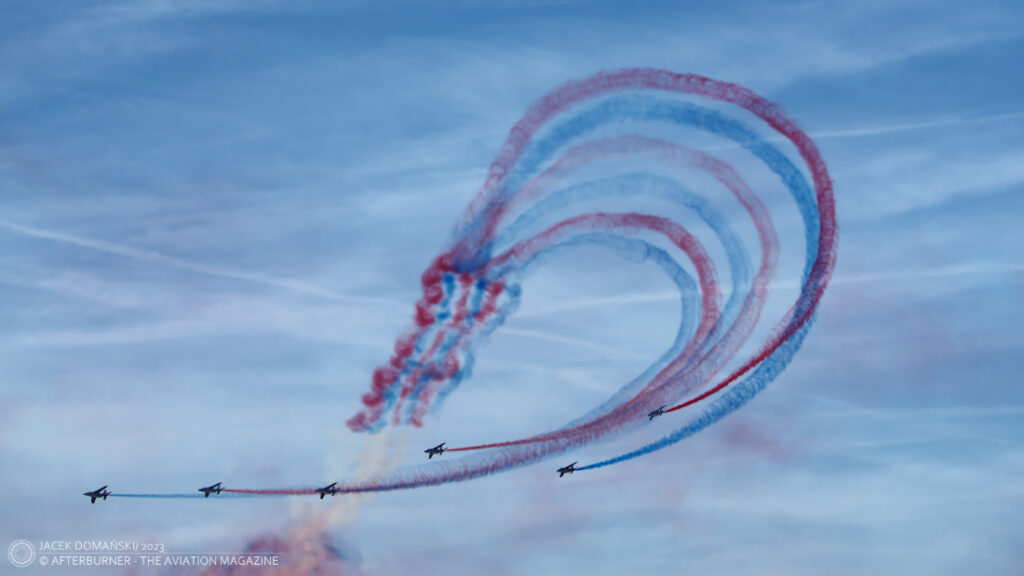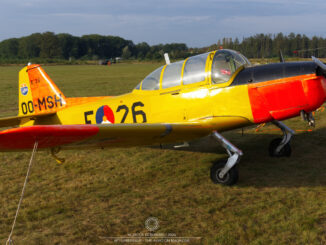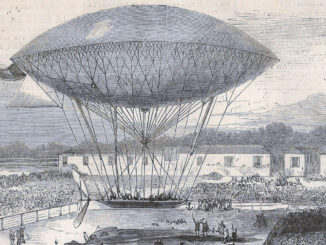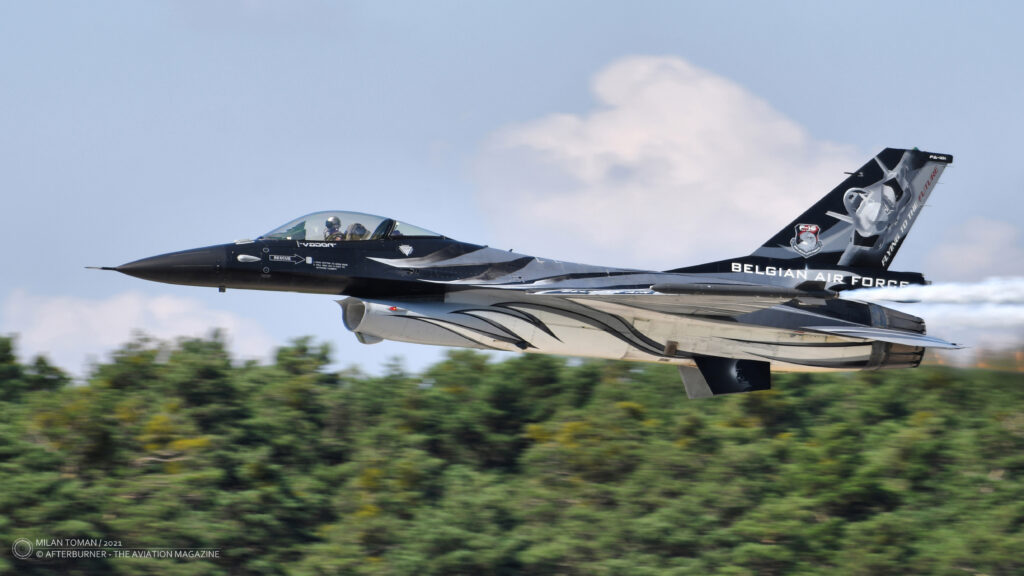 Flying displays of military aircraft are among highlights of any aviation events and, without a doubt, they are some of the most loved by both aviation enthusiasts and general public. However, in recent years we are regrettably witnessing a significant reduction of their number, caused mainly by aircraft generational change and budget cuts.
Flying displays of military aircraft are among highlights of any aviation events and, without a doubt, they are some of the most loved by both aviation enthusiasts and general public. However, in recent years we are regrettably witnessing a significant reduction of their number, caused mainly by aircraft generational change and budget cuts.
Approximately a decade ago, the air show spectators could enjoy the flying displays performed by a broad range of military aircraft. Many of them were developed during the Cold War years and the change of geopolitical situation allowed presentation of the former opponents during the same event. It was nothing particularly special to see a MiG-29 and an F-16 performing their displays one after another.
However, majority of these aircraft were at their final years of duty and successively were being successively retired from active service. In consequence, the European air show spectators are no longer able to see displays performed by MiG-21 (Romania), MiG-29 (Poland and Slovakia), Su-22 (Poland), TS-11 Iskra (Poland), Mi-24 (the Czech Republic), Harrier (United Kingdom) and Tornado (United Kingdom).
The 2010s and the 2020s were the time of generational change in the European military aviation. Such the change had already took place in the past, although no previous technical progress had similar impact on the future of the European aviation events as in the present case.
Regrettably, the developing standardization and unification of air forces of the NATO countries, together with end of service life of several types of aircraft used by them currently, is causing slow but inevitable reduction of the number of national military demo teams.
More and more European countries are currently switching to the 5th generation fighters, choosing the F-35 Lightning II as their future combat aircraft. In addition, that process recently gained a new momentum, due to outbreak of the war in Ukraine. Significant involvement of the European nations in military aid to Ukraine caused a considerable shift in defence budgets of many countries and modified their breakdown of military objectives, as well as allocated funding.
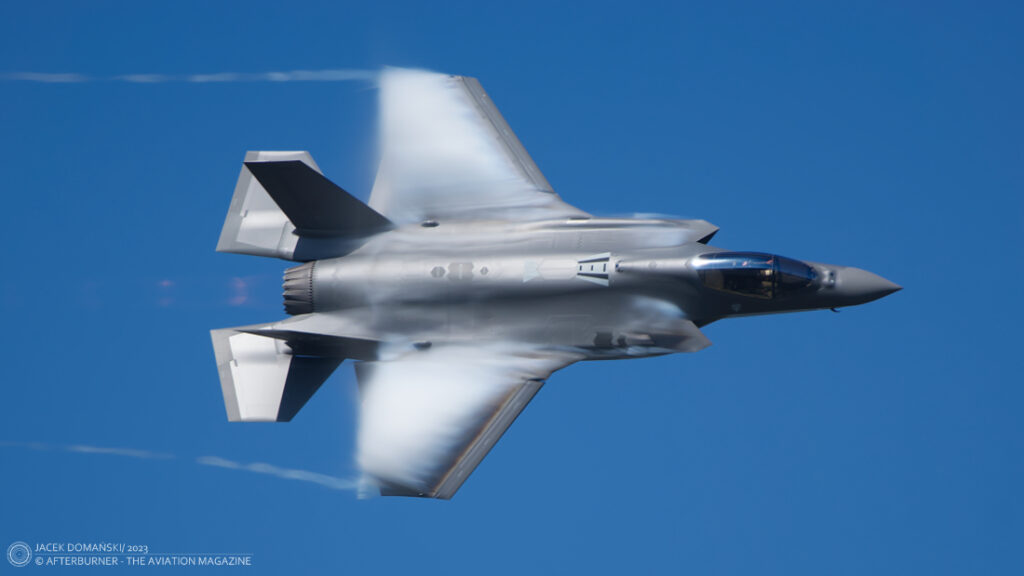
Acquirement of the 5th generation aircraft is inseparably connected with increase in spending for the military aviation. It includes not only the fighter purchase price but also expensive personnel training, huge investment in infrastructure and logistics, as well as significant increase of operational costs per flying hour. That, regrettably for the aviation enthusiasts, in the first place affects all projects not directly related to the main defence objectives, such as the display team activities.
The Royal Netherlands Air Force was the first one to announce the end of two national display teams. That decision was related to the RNLAF transition to F-35 Lightning II fighters and related increase of budget requirements.
The F-16 Solo Demo Team of the RNLAF was one of the most-recognized military display teams in Europe, due to its dynamic performance and the attractive ´Orange´ livery of its display Viper. However, the team did not renew their activity after the 2015 air show season. In December of 2018 it was officially announced that the Dutch F-16 demo was disbanded permanently.
The second Dutch display team that ceased its activity was the RNLAF Apache Solo Display Team. Its final show was performed in 2016 and then the display team was suspended for an indefinite time.
Denmark is another country with ongoing transition from the F-16 to the F-35 aircraft. In October of 2023, the first 5th generation fighters arrived to that Nordic country and retirement of the Danish Vipers is planned by 2025.
At the same time the first F-35 arrived to Denmark, the Royal Danish Air Force released its F-16 demonstration aircraft from display duties. The well-known Dannebrog performed its last flight on 12th October 2023 and soon later received the standard grey livery.
Although the RDAF F-16 Solo Display ensured that end of display duties for Dannebrog does not mean the end of the team activities – and they are yet to continue their display venture in the next years to come – we need to take into account that days of active service of the Danish Vipers, and thus the team as well, are already counted.
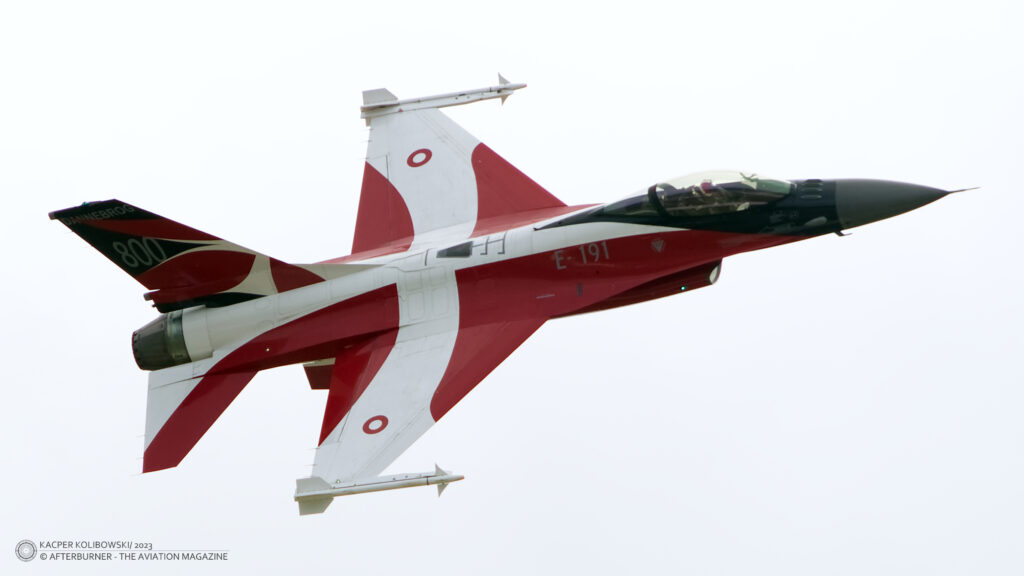
Last week, the Belgian Air Component (commonly referred to as the Belgian Air Force) officially announced the end of the country´s F-16 Solo Display team. The reasons behind that decision, as included in the statement, were the Belgian Air Force ongoing transition to the 5th generation fighters, ongoing withdrawal of the Belgian Vipers from active service due to reaching their life service limits, as well as the country´s contribution to training of Ukrainian pilots, consuming most of the BAF resources. Although fully understandable, this decision was received with sadness and resentment of literally all aviation enthusiasts, as the show performed by Belgian Viper was, for many seasons, one of the most beloved military jet display teams in Europe.
Actually, it was already the second Belgian display team that concluded its activity with the end of 2023 air show season. The first was A109 Display Team, flying the Agusta A109 light multi-purpose helicopter. The ´Razzle Blades´, as the last display helicopter was nicknamed, performed its final display in September of the last year, during the Belgian Air Force Days at Kleine-Brogel air base.
Since the late 2000s, the Belgian A109 rotorcraft are being consistently withdrawn from active duty. Currently, there are just a few helicopters of that type remaining in service with the BAF but their upcoming retirement is already a foregone conclusion.
Therefore, the Belgian Air Component – once one of the biggest and stable contributors to European air shows – will now have a very limited possibility to showcase its air power during public events. At that moment, there are only two military demo teams left in Belgium – the NH90 SAR display and the Red Devils aerobatic team.
However, the Red Devils just retired one of the team´s aircraft, SIAI-Marchetti SF-260 ´ST-35´, and during the current season the group is going to fly in formation of only three aircraft. In addition, there are rumours that, for the Red Devils, the 2024 season will be also the final one.
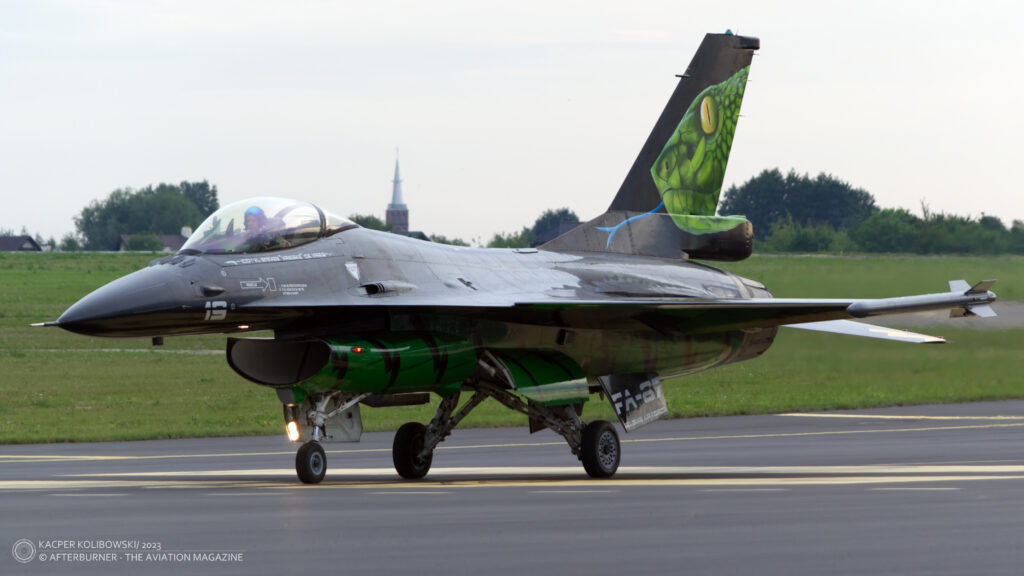
Already in 2020, the Belgian Ministry of Defence expressed its will to replace the SF-260 with new training aircraft, with the first deadline set to 2023. However, the process was delayed, and it entered the approval phase only in 2022. No further details were disclosed so far, however the Diamond Dart 550 was believed to become the future Belgian turboprop trainer. If the change means the end of the Red Devils team, or if the aerobatic groups would be reactivated with the new aircraft, is a profound enigma on the very moment.
Also unknown is the future of aforementioned NH90 SAR display. In the 2010s, Belgium acquired eight NH90 rotorcraft, four in Tactical Transport Helicopter (TTH) and another four in NATO Frigate Helicopter (NFH) configurations. However, yet in 2020, the military authorities of the country decided about the TTH withdrawal from active service, due to high operating costs and low readiness ratio.
In the near future, the NH90 TTH – as well as the remaining A109 rotorcraft – are going to be replaced by Airbus H145M Light Utility Helicopter (LUH). The next step will be to release the NFH rotorcraft from the SAR duties and assign them solely to the frigate service. Then, the SAR missions will be taken over by the H145M LUH helicopters.
In conclusion, all the Belgian military display teams – as we knew them until 2023 – will disappear within the next few years. And there is a little chance they will be ever renewed to the same extent as before.
In September of 2022, Switzerland became the next country that joined the F-35 users’ family. The contract signed by the Swiss government secured the acquirement of thirty-six aircraft that are going to be delivered between 2027 and 2030. Procurement of the 5th generation fighters coincided with discussion about the future of the best-known Swiss jet display team, Patrouille Suisse.
The Patrouille Suisse team flies with F-5E Tiger II fighter aircraft. Established in 1964, the Swiss Air Force aerobatic group is a worldwide-recognized ambassador of that Alpine country, admired by any aviation enthusiast. The issue is, the Swiss F-5Es are at the end of their lifespan and their retirement from active service is already in full swing.
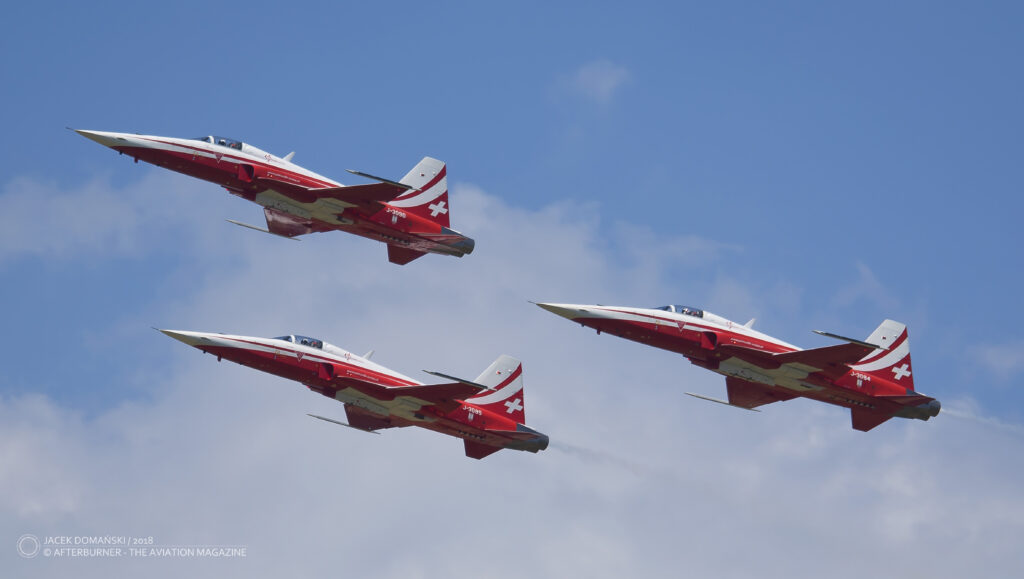
Initially, the Swiss F-5s were due to retire in 2016. However, the protracted process of purchasing the new fighter aircraft for the Swiss Air Force, extended the deadline to 2025. It secured the Patrouille Suisse operations for a few next years. Nevertheless, it seems that the Swiss authorities are not sure about the future of the national aerobatic team.
Another of the many issues the Swiss Air force is currently facing is the end of service life of its F/A-18 Hornet fighter fleet. The lifespan limit of 5,000 flying hours is expected to be achieved by the Swiss Hornets in 2025, two years earlier than the first scheduled delivery of the F-35 Lightning II aircraft is to take place. Therefore, it was already decided to extend that limit to 6,000 flying hours, by evaluating airframes of the Hornets and reinforcing possible structural weaknesses, as well as replacing some parts, if necessary.
The aforementioned issue directly affected the proposal that appeared a few years ago – to retire, almost immediately, all the F-5 fighters, including the ones assigned to the national aerobatic team. Then, the Patrouille Suisse would have to switch to F/A-18 and perform their display activities with a formation limited to only four aircraft.
However, almost at the same time, the Swiss nation approved the procurement of new fighter aircraft. Successor of the Hornet was chosen and purchase contract for the F-35 Lightning II was signed. Therefore, proposal to equip the Patrouille Suisse with the F/A-18 lost its meaning. In such case it would be an expensive transition and a temporarily solution for just a few seasons. Then, with the Hornet retirement, finally planned for 2030, the question about the future of the Swiss national aerobatic team would return again.
Although the discussion about the future shape of the Swiss Air Force jet aerobatic team began already in 2013, it seems there is no satisfactory solution at the moment. However, it is worth bearing in mind that this discussion is held at political level only, and the Swiss military authorities distanced themselves from it.
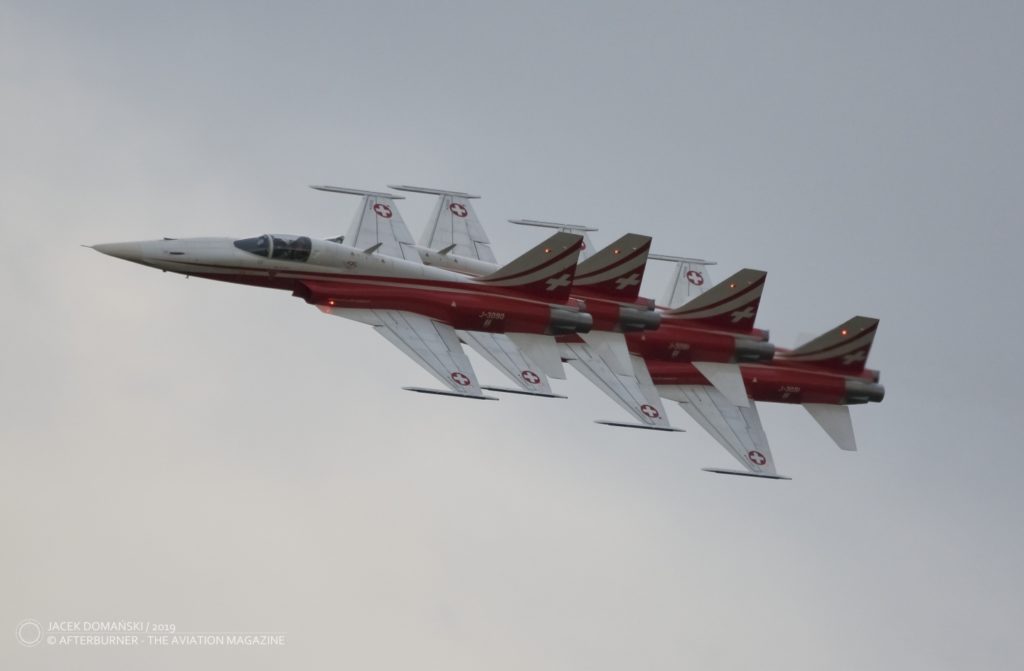
In 2020, the then Swiss Minister of Defence, Viola Amherd, told the local press that decision about the retirement of the F-5s by 2025 was final. She emphasized, that there is no reason to keep three types of fighter aircraft – F-5, F/A-18 and F-35 – on duty during the transition process. Therefore, the only possible solutions are to disband the team or to equip it with new aircraft, excluding the F-35 Lightning II.
It should be mentioned here that some influential Swiss politicians are against future operation of the Patrouille Suisse. They find the aerobatic team too expensive, totally unnecessary and think that Switzerland does not need any aircraft to create country´s folklore. Moreover, another pressure is being created by green parties – Switzerland declared to achieve ´net zero´ carbon dioxide reduction target by 2050, and ´entertainment activities´ of the armed forces are under increased criticism.
Moreover, the Swiss Armed Forces are currently in fiscal crisis. On 26th January this year, the Federal Department of Defence, Civil Protection and Sport (DDPS) announced that some of the major events planned for 2024 and 2025 had to be cancelled, due to difficult financial situation.
It included, regrettably AirSpirit24, an air show held every ten years to celebrate the jubilee of the Swiss Air Force. The 2024 edition of the event had to be held in Emmen and preparations were already under way. Therefore, the DDPS decision was received with sorrow, by both the organizational team and general public. Especially that this year is marked by the 110th anniversary of the Swiss Air Force and the 60th jubilee of the Patrouille Suisse.
In conclusion, the future of the Patrouille Suisse is still uncertain. However, it is becoming more and more probable that the team will be disbanded, and its duty will be taken over by the PC-7 aerobatic team. Additionally, the years are also already counted for the Swiss Hornet Solo Display. Due to the F/A-18 retirement, the team will – sooner or later – share the fate of the Dutch and Belgian fighter display teams.
The aforementioned issues are just examples of changes that affect the air forces in the near future and are a cause of concern for the European aviation enthusiasts. For the latter, it seems that the late 2020s would be marked by far greater reduction of military display teams.

In 2022, Finland finalized its bid for country´s future aircraft, also by purchasing the F-35 Lightning II. The new jets are going to be delivered in 2026 and, in terms of the military display teams, it would mean the conclusion of the Finnish F/A-18 Solo Display Flight.
In January of 2024, similar decision was made by the Czech government. The first F-35 is expected to arrive to the Czech Republic in 2031, denoting the end of the country´s JAS-39 Gripen and Aero L-159 ALCA display teams.
In 2023, the French Air Force retired the Alpha Jet aircraft from their main role of training the student pilots. Within that duty, the Franco-German jet was already succeeded by Pilatus PC-21 turboprop trainer. However, the Alpha Jet service with the French Air Force did not come to definitive end yet, as the aeroplanes are still used for ´aggressor´ duties, as well as by the French national aerobatic team, Patrouille de France. Nevertheless, the aviation enthusiasts must reckon with the fact the Alpha Jet is also slowly approaching the end of its service life. Thus, keeping the aeroplane in active service just because of the Patrouille de France activities may shortly become economically viable.
However, an interesting solution was implemented on the other side of the English Channel. In 2022, the Royal Air Force retired all its Hawk T1 trainers from frontline service, but not the examples used by the national aerobatic team, the RAF Red Arrows. The nearest future of the British icon was saved by sponsorship deals. Some of the biggest companies in the country, such as BAe, Barbour, Land Rover and Rolls-Royce agreed to provide financial support for the RAF Red Arrows. Therefore, the future of the British jet aerobatic team was secured for at least a decade.
Nevertheless, it seems that the golden years of European military aviation teams are inevitably coming to the end. The 2020s seems to be the last decade with a broad diversity of aircraft and displays due to cumulation of the three above mentioned reasons – end of lifespan of the aeroplanes developed during the Cold War era, the aircraft generational change and unification towards the 5th generation aeroplanes, as well as the financial reasons. Not mentioning the carbon dioxide reduction goals.

It is rather impossible to the countries that decided to purchase the F-35 Lightning II fighters to establish national display teams, to the same extent as it was with the F-16s, the F/A-18s and other 4th generation aircraft. Regrettably, for their military budget, operation of the F-35 in the role of display jet may be just prohibitively expensive.
Currently, the United States Air Force is the sole operator of the official F-35 display team. Nevertheless, its operation is, to a large extent, focused on supporting marketing and sales of that 5th generation fighter.
In conclusion, it is important to answer the question if the military display teams are needed at all. Without any doubts, the main objectives of any armed forces are related to defence issues, not public entertainment. This view is shared by many politics, military authorities and even some aviation enthusiasts.
Although not lacking some reasons, such opinions are not taking under consideration the role of armed forces in nowadays society. First of all, among the Western society, they became just one of many employers in the country. Therefore, were faced to find ways how to attract young people to join the army. In addition, in democratic countries the armed forces are under public control and tax payers carefully analyse any new procurement and, broadly understood, sense of security.
Showcasing the modern military equipment and its abilities is one of the most effective ways to respond the aforementioned needs. And aviation displays are among the most spectacular ones, as well as the easiest to arrange – a flypast or display can be performed practically everywhere. Several military authorities, including the British and American ones, already mentioned that military aviation displays are very effective, and constitute important recruitment pillars.
It should not be forgotten that, for example, the national aerobatic teams are not only the effective ambassador of any country, but they also became recognisable brands, with huge fan communities. Activities of the display teams affect many different aspects, even those completely unrelated to national defence objectives.
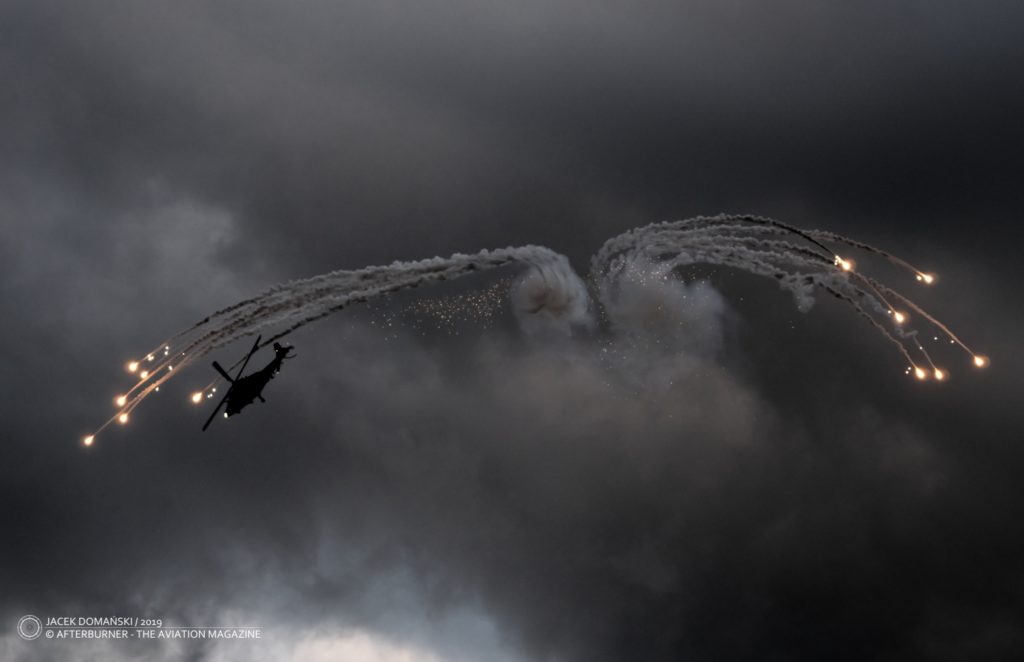
Cancellation of the abovementioned AirSpirit24 air show in Switzerland had a consequent negative impact on economy of the Emmen/Lucerne region. Usually, the Swiss Air Force anniversary event attracts more than 100,000 spectators each day and, as the local press reported, all hotel rooms in the area were already fully booked until the end of 2023 by potential air show visitors. The entire region was awaiting the event, considering it as economically beneficial.
Similar situation is with defence show organized annually at Ostrava-Mošnov airport in the Czech Republic. Each edition attracts more than 100,000 domestic and international spectators daily. Military equipment showcases, as well as variety of dynamic displays in the air and on the ground, are the only reason for the visitors to come there.
The importance of military displays was recently proved in the United Kingdom. This year, the RAF Red Arrows are going to visit Canada, within their Maple Hawk 2024 tour. The journey is focused on supporting the centennial of the Royal Canadian Air Force and will take place in August and September of 2024.
That information immediately caused cancellation of a few traditional British aviation events, where the RAF Red Arrows were initially scheduled to perform at. The list includes Folkestone Air Display, Sidmouth Air Show and Rhyl Air Show – organizers of all those events announced that cancellation of the RAF Red Arrow display forced their decision.
Certainly, all those aviation events have a lot more to offer for any aviation enthusiast, nevertheless it is general public that makes up the majority of any air show visitors. For them, such aerobatic teams as the RAF Red Arrows are the main – if not only – reason to visit the event. And with perspective of significantly less visitors to come, there is usually no point to hold a locally organized air show.
And, last but not least, the military display teams are also an important supporter of different charity activities. According to the British MoD, each year the RAF Red Arrows displays help to raise thousands of pounds for charitable purposes. And it is the same with other military display teams that support several charity activities on daily basis.
